The C-frame style of valve spring compressor has become the preferred tool for disassembly and re-assembly of the standard applications like Chevy and Ford. These compressors work with air and a special jaw presses on the retainer, allowing you to remove the keepers quickly and safely. There are also manual versions of the C-frame compressor that utilize an over-center cam clamp for compressing the spring. This style was the basis for adding the air cylinder to do the work of compressing the retainer. Both units come in a variety of sizes and have optional jaws for the various diameters of retainers. These types of spring compressors are good for stock springs up about 300 to 350 lbs.
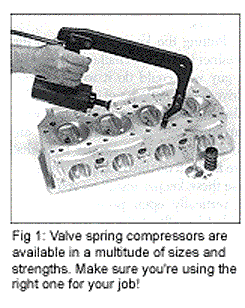
The “killer” springs of the high performance world need a killer, heavy-duty type of air spring compressor. These springs can have as much as 900 pounds of pressure and if you’re not using the proper tools, you can be seriously injured or worse. These heavy-duty spring compressors are made from T-6 aluminum so they won’t flex during the compression of the retainer but are still light enough to handle easily. I strongly recommend using a solid jaw rather than an adjustable one when working on high-performance heads. With a solid jaw there is no chance of flexing or twisting keeping the retainer from shooting off into space or possibly hitting you in the face (see Figure 1).
There is another way to take these killer springs off safely. It’s to use a tool that looks like a C-Clamp. They’re not real fancy, require a little arm strength but still get the job done. These modified C-clamps units have a specially designed receiver or jaw, so you can remove and install keepers safely. I’ve watched the Top Fuel guys using both air and manual compressors on very hot heads right after a 330 mph run and both work well.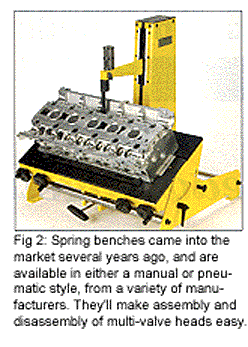
However, when it comes to the multi-valve overhead cam cylinder heads, the hammer and socket definitely need to be put in the tool box and the C-frame compressor is compromised due to the very small diameter and sometimes very deep lifter bores that we need to go through to get at the retainers and keepers. You need a tool designed specially for this job.
Spring benches came into the market several years ago, and are available in either a manual or pneumatic style, from a variety of manufacturers (see Figure 2).
I like the spring bench for a couple of reasons: 1) you have a dedicated workspace and 2) all of your tools stay in one place. One thing all spring benches have in common is that they protect the lifter bore from damage. It is very important to not damage the lifter bore during disassembly or assembly.
Spring benches also support or hold the valve securely. Valve stems on multi-valve OHC cylinder heads are getting down to 4mm and manufacturers are putting not two, not three 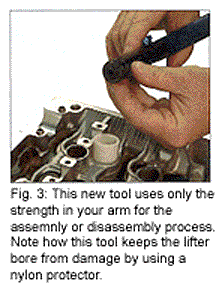
but up to four or five valves into the combustion chamber. With these small sizes, there is potential for bending the valve, which you naturally want to avoid. What makes the spring bench ideally suited for these heads is that a support holds the valve in place by pushing up on the valve head while an open-design pressing foot compresses the spring allowing access to the keepers and retainers.
Putting the keepers back into the retainer is the next challenge. I’ve seen a guy who could do it with a screwdriver and a little bit of grease but I’ve also witnessed group efforts that were anything but successful. There are some spring-loaded keeper tools that are fast and do the trick every time. To use these keeper installers you’ll need a vertically open pressing foot. An added benefit of the spring bench is that they make the entire re-assembly process much faster. You can ensure your valve stem seals are positioned properly and on the higher end benches you even have the ability to install the cam and set the lifters.
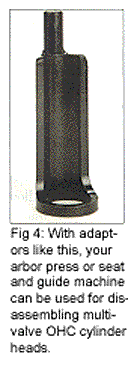
Another really cool tool that’s relatively new uses only the strength in your arm for the assembly or disassembly process. (see Figure 3). Note how this tool keeps the lifter bore from damage by using a nylon protector.
Another way to get these multi-valve overhead cam cylinder heads apart is to use an arbor press or your seat and guide machine. These machines can act as your assembly and disassembly bench using adapters like this (see Figure 4). Keep in mind you still need to have a way to keep the valve from opening during the pressing operation. You can use a piece of wood or small bags filled with shot placed in the combustion chamber. This will prevent the valve from opening during the pressing process. Be careful to not damage the lifter bore or bend the valve.
Ok, now you have the springs off, what about the valve stem seals? Some of these valve stem seals seem like they are welded to the guide, they are so darn tough to remove. What 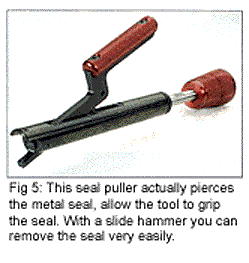
do you do? You can try pliers but the clamping action actually makes the seal tighter. You need to get under the seal and use a slide hammer to get the seal off the guide.
Some of these steel jacketed seals make the job even more difficult because you can’t get under the seal to remove it. I found a seal puller that actually pierces the metal seal, allow the tool to grip the seal and then using a slide hammer you can remove the seal very easily (see Figure 5).
Installing the new seals is easier than removing them. There are tools made specifically for this job and they incorporate a sleeve that is installed over the valve. This sleeve does two things; 1) it enlarges the ID of seal during the installation and 2) it stops the keeper grooves in the valve stem from tearing the ID of the valve stem seal.
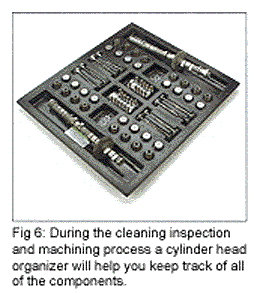
Taking the OHC cylinder head apart and putting it back together is one thing. But during the cleaning (you knew I’d get to this eventually), inspection and machining process it’s a challenge to keep track of all of these components. Get yourself a cylinder head organizer. These organizers have compartments to keep everything in order and all in one place (see Figure 6). Now you can keep all of these components in an organized manner. This is very important when its time to put everything back together again.
Remember you can’t clean it or machine it until you take it apart. Do it right and you make money and satisfy your customers at the same time!
See you in the shop!
Dave Monyhan is national sales manager with Goodson Shop Supplies, located in Winona, MN. He can be reached by email at [email protected].













